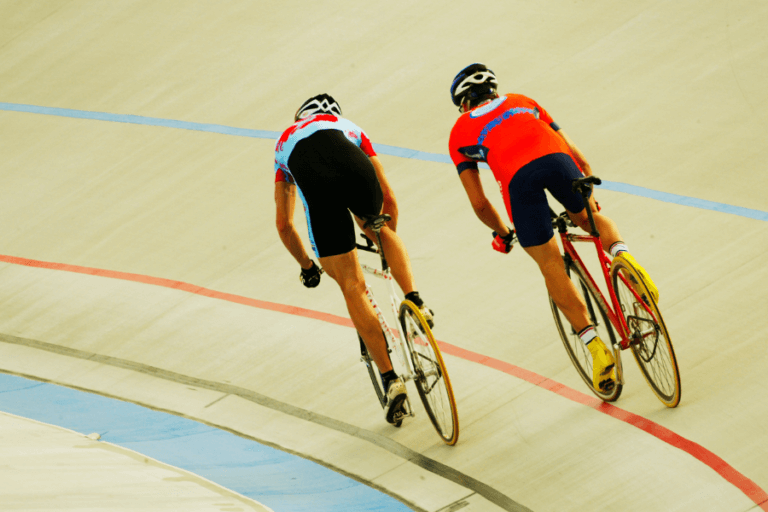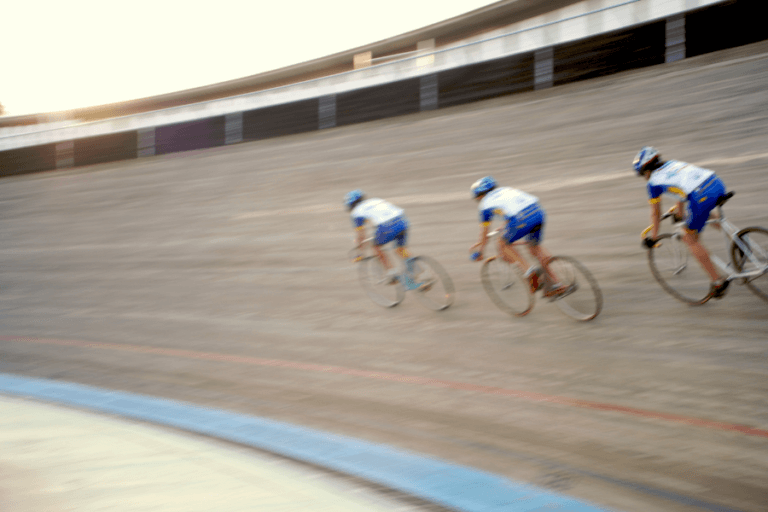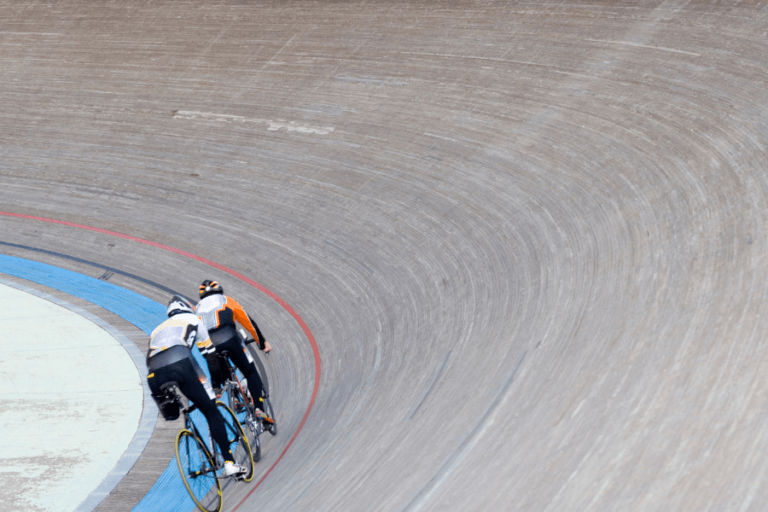Track cycling is fast-paced and a great workout, but you’ll need both a specialized bike and sharp technical skills.

Track cycling is a bicycle racing sport held on banked tracks or in velodromes. It requires power, strength, speed, endurance, and strategy. While it isn’t an easy hobby, track cycling has many benefits.
Before you grab your bike and ride to the nearest velodrome, let’s talk about the basics.
Find The Right Track Bicycle
Track bicycles might look similar to road bikes, but they are different in a few ways. They are built for resilience, speed, and made specifically for tracks. The design is centered around aerodynamics, which makes them lighter than typical bikes.
Track bikes don’t have gears or brakes — you’ll have to learn how to slow down, accelerate, and stop your bike. They are designed with a single cog and chainring and don’t have brake calipers and levers.
Unlike road bikes, track bikes have a high bottom bracket that allows enough room between steep bank surfaces and your pedals. The seat and head tube is placed at a steeper, more aero angle — this enhances the steering response and maneuverability. The simple geometry of track bikes plus their aerodynamics make them fast and efficient.
The Frame
Most times, track bike frames are made of carbon or aluminum. They must be able to withstand crash-related impacts and aggressive races.
Carbon is a popular choice because it is lightweight, durable, and comfortable to ride. However, carbon track bikes are more expensive. Carbon can be brittle and easily shatter in a crash. But for many competitive cyclists, a damaged frame is worth the risk.
While aluminum is heavier than carbon, it is more durable and resilient. While it might not shatter on impact like carbon can, it can still be dented in a way that could interfere with its functionality. Don’t make the mistake of comparing track bicycle aluminum to a soda can — today, aluminum can be manipulated for comfort and strength.
The Brakes
Well, there aren’t any. Road bikes have front and rear brakes, and beach cruisers have coaster brakes. Track bikes don’t have a brake system at all.
Sure, it sounds dangerous. However, track cycling in a velodrome is one of the safest ways to ride. There are several ways to slow down, but it’ll take practice.
The Gears
Track bicycles run on a single gear. The bike is designed to go fast, but with only one gear you’ll need strong legs to get it going.
If you find it hard to move or experience knee pain, you can upsize the rear cog until you build up strength and endurance. Track bikes cannot coast because there is no freewheel — it only moves when you pedal.
The Cranks
If you experience hip or knee pain on your track bike it’s probably because the crank arm is too long. Otherwise, you probably won’t need to touch the cranks.
Don’t try to guess your crank size. Leave that to the professionals. They can fit you with the correct size and you’ll be pain-free in no time.
The Tires
Probably one of the most important aspects of your bike, there are two different types of tires on track bikes — tubular or clincher. Each one has a different construction and function. And don’t forget to consider width, tread, and durability!
Tubular tires are a single, completely round piece with no open parts. They don’t need a separate tube because it comes already sewn in, making tubular tires more lightweight. And since they don’t have a clincher bead — a part of the tire that allows it to grip the wheel — they must be glued or taped to the rim. This also makes tubular tires more balanced and aerodynamic.
Clincher tires are the exact opposite — they are easy to change and consist of a tube and tire. They hug the rim tightly, and no glue or tape is required. Some cyclists find that clincher tires are the faster option, which makes them better for speed races.
It’s important to note that in general, clincher tires function well on outdoor tracks, and tubular tires are better for indoor tracks.
Cycling In A Velodrome

A velodrome is an oval-shaped track in an arena or stadium made for track cycling. The tracks have large, steep banks — but the steepness and track size vary by venue.
For reference, in an Olympic-sized velodrome, tracks are a minimum of 250 meters in circumference. Standard velodromes range from 150 to 500 meters.
Indoor tracks are made with different materials than outdoor tracks. Most indoor tracks are constructed with boards made from timber, synthetics, or a combination of both. Indoor tracks contain asphalt, concrete, or wood. You must consider these materials when you choose where to ride and what kind of tires to purchase.
Prerequisites
Track cycling is carefully regulated and monitored. Most velodrome arenas require that you take a series of safety courses before you begin. They need to ensure that you know how to ride on the track safely and are familiar with the rules and regulations.
Train
Now that you’re familiar with the arena, it’s time to train on the track! Your coach will incorporate games, drills, and exercises into their sessions. It might be hard at first, but practice and consistency makes perfect. Ride weekly (or daily!) and you’ll get the hang of it in no time.
Race
There are two main categories you can race in — sprint or endurance.
Sprint races focus on your power and technique. While it might seem simple to quickly pedal your way to victory, a sprint race requires specific speed tactics over a small number of laps. Different types of sprint races include team sprint, keirin, chariot, and track time trial.
Endurance races test your endurance capacity, race tactics, and speed. You must ride fast and incorporate your skills for a long time. Endurance race types include both individual and team pursuit, points race, scratch race, omnium, and madison.
The Benefits of Velodrome Track Racing

Track racing is a good way to improve your overall riding skills. Plus, the level of focus and technical skill required is easily transferred to road and mountain biking. With just a few track cycling sessions, you’ll notice an improvement in all aspects of your biking abilities.
If you want to build your cycling skills and challenge yourself on the bike, velodrome track racing is for you. It’s an opportunity for you to push the boundaries to get faster, stronger, and healthier.
What are you waiting for? Start track cycling today. You might even find yourself hooked after just one event — it’s an addictive hobby when done right! But every hobby comes with a price, and the cost of track cycling can be steep. Protect your bike and gear with lost-cost insurance options.
